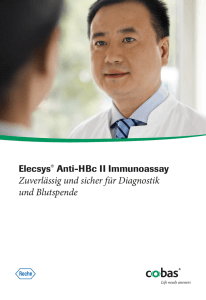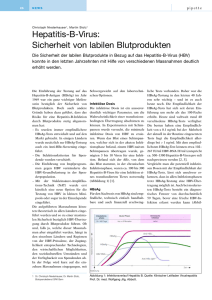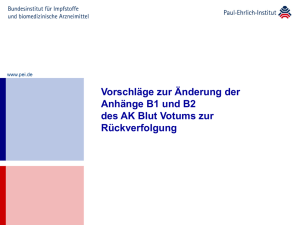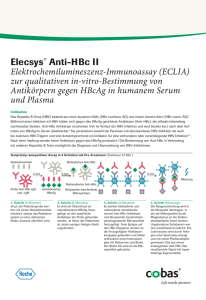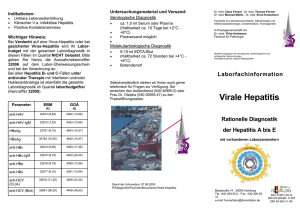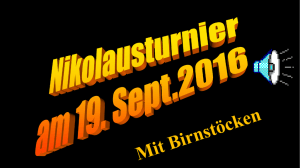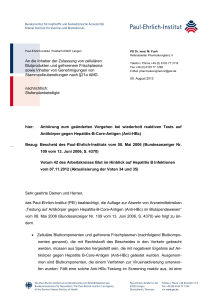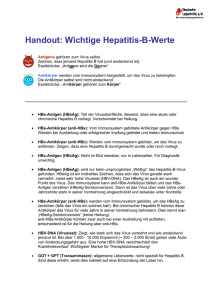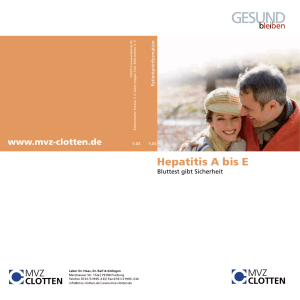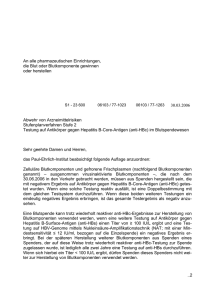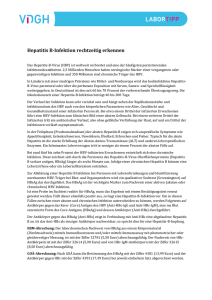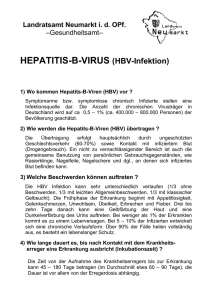Infektiosität von HBsAg-negativen, Anti-HBc - Paul-Ehrlich
Werbung
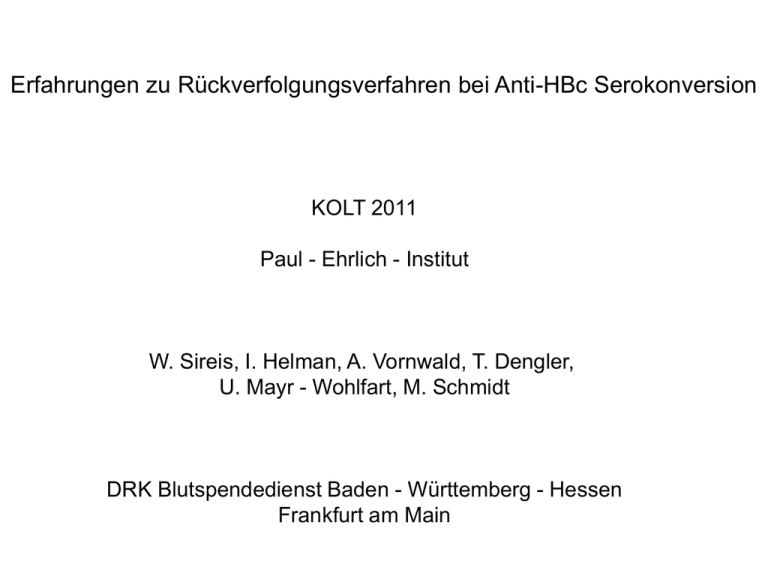
Erfahrungen zu Rückverfolgungsverfahren bei Anti-HBc Serokonversion KOLT 2011 Paul - Ehrlich - Institut W. Sireis, I. Helman, A. Vornwald, T. Dengler, U. Mayr - Wohlfart, M. Schmidt DRK Blutspendedienst Baden - Württemberg - Hessen Frankfurt am Main HBsAg neg Anti-HBc neg Look- back: Empfänger-Testung HBsAg neg Anti-HBc neg HBsAg neg Anti-HBc pos Anti-HBs > 1000 U/l Infektiosität von HBsAg-negativen, Anti-HBc- positiven Blutspenden Anti-HBc Cut off HBV-PCR (single) ALT (13-22 U/l) Anti- HBs HBs-Ag 03/95 02/96 05/95 09/96 04/97 07/97 11/97 03/98 01/99 Anamnestische Hepatitis B (1978) 02/99 Blutspenden *Meldung einer HBV Infektion, Empfängerin geb. 14.05.57; Diagnose: M. Hodgkin ** Sequenzierung: Übereinstimmung der C- und S- Gene W.Sireis, ISBT 2002 Vancouver RESULTS OF LOOK_BACK OF HBV, HCV AND HIV FROM 1997 TO 2001 W. Sireis, W. Weichert, H. Bialleck, S. Findhammer, E. Seifried Vox Sanguinis, Volume 83, August 2002 Conclusions: “For HCV and HIV no transmission could be verified. Some donors may show HBV borderline viremia which will not be detected even by HBsAg ELISA`s and pool-HBV-PCR. Anti-HBc screening would surely detect these donors. The transmission and symptomatic infection of a recipient in this case probably depend on the immune status of recipients and on the virus dose”. Erfahrungen zu Rückverfolgungsverfahren bei Anti-HBc Serokonversion Formale Definition einer Ant - HBc Serokonversion - Vorspende Anti - HBc negativ - Aktuelle Spende Anti - HBc positiv Bei einer Serokonversion ist ein Look back Verfahren einzuleiten RSP negativ: keine weitere Maßnahmen RSP positiv (DNA positiv): Fortführung des Verfahrens Zahl der Ant i - HBc Serokonversionen 2006* 2007* 2008 2009 2010 Summe 84 118 179 140 136 657 Echte Anti-HBc Serokonversion 0 1 4 2 4 11 Anti-HBc & HBV DNA positiv (okkulte Infektion) 4 4 0 1 1 10 Verdacht auf Anti - HBc Serokonversion (Pseudoserokonversion) * Daten aus Baden - Württemberg - Hessen und Nord ab 2008 zusätzlich: DRK Ost Inzidenzen der aHBc-Serokonversionen 2008 2009 2010 13,6 10,7 9,8 Echte Anti-HBc Serokonversionen / 100.000 Spenden 0,3 0,2 0,3 Anti-HBc & HBV DNA positiv (okkulte Infektion) / 100.000 Spenden 0,0 0,1 0,1 Verdacht auf Anti-HBc Serokonversionen / 100.000 Spenden (Pseudoserokonversion) Echte Serokonversion Parameter aHBc; 1.Testsystem aHBc; 2.Testsystem Vorspende Auffällige Spende Zweite Blutprobe 15.03.2007 19.07.2007 03.08.2007 negativ s/co 1,73 positiv s/co 0,05 positiv s/co 0,05 negativ n.d n.d aHBC IgM negativ n.d positiv aHBs negativ 545 IU/l >1000 IU/l HBV NAT negativ negativ negativ HBsAg negativ negativ negativ Echte Serokonversion Vorspende Auffällige Spende Zweite Blutprobe 23.08.2006 08.12.2008 02.01.2009 0,04;0,04;0,04 0,04 0,144 0,051 n.d n.d n.d aHBs 0 26 41 aHBe negativ positiv positiv HBV NAT negativ negativ negativ HBsAg negativ negativ negativ Parameter aHBc; 1.Testsystem aHBc; 2.Testsystem aHBC IgM negativ s/co 1,65 negativ s/co 1,83 Okkulte HBV Infektion, Look-back Parameter Vorspende 3 Vorspende 2 Vorspende 1 36 Monate zuvor (2003) 33 Monate zuvor (2003) Auffällige Spende Zweite Blutprobe 3 Monate zuvor 2006 1,5 Monate später Ältesten vorhandenen Proben aHBc; 1.Testsystem positiv positiv positiv positiv positiv n.d n.d n.d n.d n.d aHBC IgM n.d n.d n.d n.d aHBs n.d n.d n.d negativ HBV NAT negativ negativ negativ positiv positiv HBsAg negativ negativ negativ negativ negativ aHBc; 2.Testsystem Nachuntersuchung der vier direkten Vorspenden: Zwei Empfänger wurden nachuntersucht: beide sind aHBc, aHBe positiv, aber HBV DNA, HBsAg und aHBs negativ Characterization of 188 antiHBc-reactives antiHBc-reactivity in 9 different assays 9/9 assays one second marker pos both second markers pos 5-8 assays 1-4 assays 8 5 antiHBc only 13 antiHBc + antiHBs 63 50 11 2 antiHBc + antiHBe 7 7 0 0 antiHBc + antiHBs + antiHBe 105 105 0 0 188 162 (86.2%) 19 (10.1%) 7 (3.7%) 168 (89.4%) antiHBs-pos Schmidt, Nübling V 34 Anhang B 2 Hepatitis-B-Virus (HBV) Labordiagnostik zur Feststellung des Infektionsstatus Erste Blutprobe Gemeinsamer Vorschlag: Frau Dr. M. Heiden, Herr MUDr. W. Sireis, Herr PD Dr. M. Schmidt HBsAg negativ Anti-HBc1 wiederh. Reaktiv und HB-NAT2 Anti-HBs quantitativ HBV-NAT negativ Anti HBs ≥ 100 IU/L Zustand nach HBV Infektion3,4 Anti HBs 10-100 IU/L Zustand nach HBV Infektion3,4 Anti-HBe Anti-HBs negativ Zweiter Anti-HBc Test rep. positiv Spender ausscheiden, Abklärung beim Hausarzt Verdacht auf HBV Infektion Nachuntersuchung negativ positiv3,4 negativ Anti-HBc unspezifisch reaktiv HBV DNA positiv der RSP HBV-NAT positiv bestätigt positiv 1 Gilt nicht für Plasma aus Apherese, das ausschließlich zur Fraktionierung verwendet wird. 2 Testung mit hochempfindlicher NAT, analytische Sensitivität 12 IU/ml bezogen auf die Einzelspende. 3 Bei gesichert positiver HBV Impfanamnese kann optional die Spezifität des Anti-HBc-Befundes weiter abgeklärt werden (z.B. weitere Anti-HBc Testsysteme, endgültige Anti-HBc-Befundbeurteilung nach dem 2:1 Prinzip). 4 Bei Zustand nach Hepatitis B Erkrankung sind die Sperrfristen gemäß Hämotherapie-Richtlinien zu beachten. V 34 Anhang B 2 Hepatitis-B-Virus (HBV) Labordiagnostik zur Feststellung des Infektionsstatus Erste Blutprobe Gemeinsamer Vorschlag: Frau Dr. M. Heiden, Herr MUDr. W. Sireis, Herr PD Dr. M. Schmidt HBsAg negativ Anti-HBc1 wiederh. Reaktiv und HB-NAT2 Anti-HBs quantitativ HBV-NAT negativ Anti HBs ≥ 100 IU/L Zustand nach HBV Infektion3,4 Anti HBs 10-100 IU/L Zustand nach HBV Infektion3,4 Anti-HBe Anti-HBs negativ Anti-HBc unspezifisch reaktiv HBV-NAT positiv negativ positiv3,4 bestätigt positiv 1 Gilt nicht für Plasma aus Apherese, das ausschließlich zur Fraktionierung verwendet wird. 2 Testung mit hochempfindlicher NAT, analytische Sensitivität 12 IU/ml bezogen auf die Einzelspende. 3 Bei gesichert positiver HBV Impfanamnese kann optional die Spezifität des Anti-HBc-Befundes weiter abgeklärt werden (z.B. weitere Anti-HBc Testsysteme, endgültige Anti-HBc-Befundbeurteilung nach dem 2:1 Prinzip). 4 Bei Zustand nach Hepatitis B Erkrankung sind die Sperrfristen gemäß Hämotherapie-Richtlinien zu beachten. Erfahrungen zu Rückverfolgungsverfahren bei Anti-HBc Serokonversion Zusammenfassung 1. Die derzeitige Definition für eine Anti - HBc Serokonversion ist nicht ausreichend 2. Bei der Bewertung müssen weitere Parameter, z.B. Anti - HBe berücksichtigt werden 3. Merkmale (Testparameter) zur Unterscheidung einer unspezifischen und echten Serokonversionen sollen definiert werden 4. Die Schemata des AK Blut sollen entsprechend angepasst werden Vielen Dank für Ihre Aufmerksamkeit !
